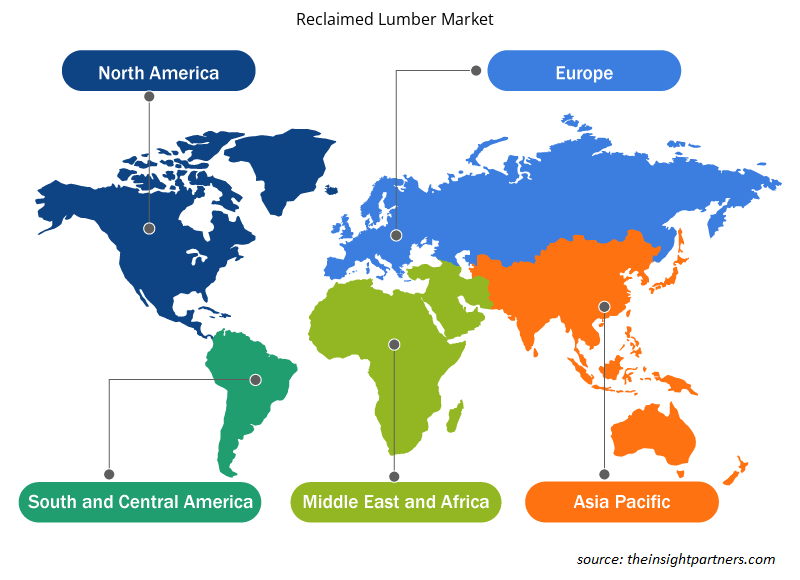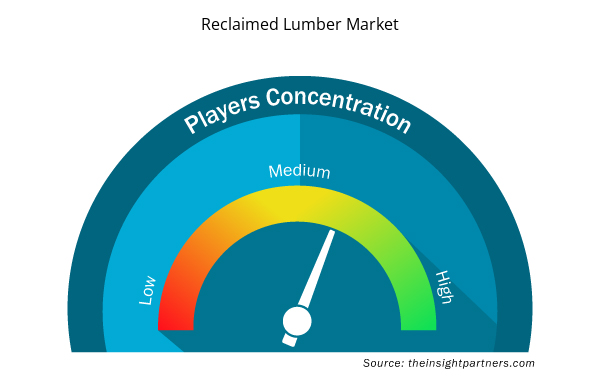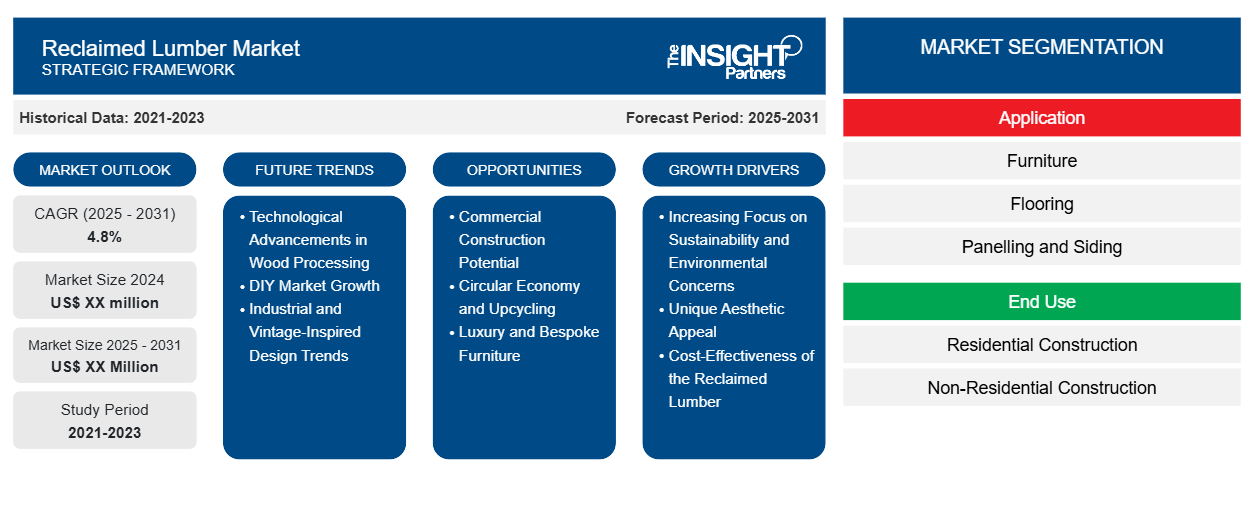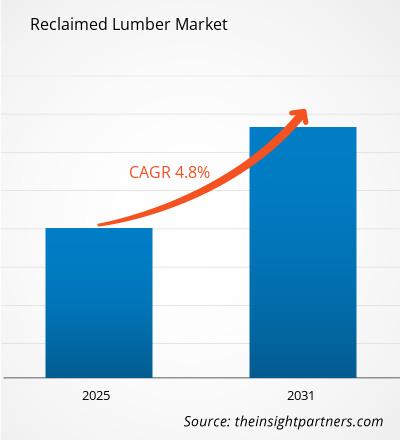预计再生木材市场在 2023 年至 2031 年期间的复合年增长率为 4.8%,市场规模将从 2023 年的 XX 百万美元扩大到 2031 年的 XX 百万美元。
报告按应用细分(家具、地板、镶板和壁板等)。报告进一步按最终用途细分(住宅建筑、非住宅建筑等)。报告范围涵盖五个地区:北美、欧洲、亚太、中东和非洲、南美和中美洲以及每个地区下的主要国家。全球分析进一步细分为区域和主要国家。报告以美元为单位提供上述分析和细分的价值。
报告目的
The Insight Partners 发布的《再生木材市场》报告旨在描述当前形势和未来增长、主要驱动因素、挑战和机遇。这将为各种业务利益相关者提供见解,例如:
- 技术提供商/制造商:了解不断变化的市场动态并了解潜在的增长机会,从而能够做出明智的战略决策。
- 投资者:对市场增长率、市场财务预测以及整个价值链中存在的机会进行全面的趋势分析。
- 监管机构:监管市场政策和警察活动,旨在最大限度地减少滥用行为,维护投资者的信任和信心,维护市场的完整性和稳定性。
再生木材市场细分
应用
- 家具
- 地板
- 镶板和壁板
最终用途
- 住宅建筑
- 非住宅建筑
定制此报告以满足您的需求
您可以免费定制任何报告,包括本报告的部分内容、国家级分析、Excel 数据包,以及为初创企业和大学提供优惠和折扣
- 获取此报告的关键市场趋势。这个免费样品将包括数据分析,从市场趋势到估计和预测。
再生木材市场的增长动力
- 日益关注可持续性和环境问题:全球对气候变化和环境恶化问题的关注导致对可持续建筑材料的需求不断增加。使用再生木材可减少对新木材的需求,从而保护森林并减少森林砍伐。这有助于可持续实践,这与环保价值观以及消费者和企业方面(特别是在建筑和室内设计行业)相得益彰。随着 LEED(能源与环境设计先锋)等绿色建筑认证的兴起,再生木材正成为可持续建筑项目的抢手材料。eco-conscious values and on the consumer's and the business side, specifically in construction and interior design businesses. With more green building certifications, such as LEED (Leadership in Energy and Environmental Design), on the rise, reclaimed lumber is becoming a sought-after material for sustainable construction projects.
- 独特的美学吸引力:再生木材因其独特的外观而成为当代建筑和室内设计中最受推崇的元素之一。再生木材的风化外观、古铜色和历史价值使其成为古董。消费者和设计师正在寻找有故事或历史的材料。这一趋势推动了再生木材市场的发展,再生木材可以应用于家具、地板、装饰墙和其他人们重视原创完整性的装饰用途。
- 再生木材的成本效益:由于供应链中断、劳动力成本和伐木限制等原因,新木材的成本多年来一直在上涨。这使得再生木材成为一个有吸引力的选择,因为它可能比购买新木材更便宜,尤其是考虑到可以从拆除中获得的再生木材。此外,由于法规限制和木材枯竭,资源稀缺。所有这些都使得再生木材的使用更加可行,可以为建筑商和承包商提供具有竞争力的价格的优质材料。
再生木材市场未来趋势
- 木材加工技术进步:回收行业的技术发展促进了加工和成品再生木材的生产。如今,改进的锯木厂、打磨机械和精加工技术对生产外观均匀的高质量再生木材产品做出了巨大贡献,从而为多样化的应用提供了广阔的空间。这些创新使再生木材能够满足新木材的标准。因此,它可以应用于更多项目,例如高端商业建筑和豪华住宅。
- DIY 市场增长:DIY 产品市场已经回暖,尤其是自 COVID-19 疫情爆发以来,人们想要改善家居环境。再生木材的使用也在增加。再生木材用于制作家具、架子和装饰品。这创造了新的再生木材供应,对 DIY 爱好者的小型预切木板和套件的需求也在上升。
- 工业和复古风格的设计趋势:工业和复古风格的设计在家庭和商业场所中的使用日益增多,这推动了对再生木材的需求。这种趋势在城市阁楼、餐厅、办公室和精品酒店中尤为明显,这些地方更倾向于原始、质朴的美学。这些设计趋势的核心是再生木材。它为空间增添了温暖、个性和历史感。消费者对那些能让他们想起工艺和真实性的材料的喜爱推动了对带有明显磨损、钉孔和其他前世痕迹的木材的需求不断增长。
再生木材市场机会
- 商业建筑潜力:虽然再生木材通常用于住宅和室内设计,但它的商业建筑潜力越来越大。公司越来越多地寻求用于办公楼、零售空间和公共建筑的可持续材料。再生木材可用于地板、镶板、天花板和结构梁。对环保办公空间和商业地产的需求为再生木材供应商进入这一市场带来了新的机会。
- 循环经济和再利用:随着越来越多的企业和政府采用循环经济原则,对回收和再利用材料的需求不断增长。再生木材非常适合这种模式,因为它是由拆除建筑物中的旧木材重新利用并赋予其新的生命。对于采购、加工和销售再生材料的公司来说,这是一个巨大的市场机会。这还将日益抢占那些能够有效收集和再利用旧木材进行建筑垃圾管理的企业的市场份额。
- 豪华定制家具:豪华定制家具行业是再生木材的重要商机。高端家具制造商越来越多地使用再生木材来制作独特的家具。这些家具产品以可持续和独特为卖点,正受到追求真实性、工艺和环保意识的高收入消费者的青睐。定制再生木家具(从桌椅到橱柜)在住宅和商业室内装饰中越来越受欢迎,尤其是在豪华住宅和酒店市场。
再生木材市场区域洞察
Insight Partners 的分析师已详细解释了预测期内影响再生木材市场的区域趋势和因素。本节还讨论了北美、欧洲、亚太地区、中东和非洲以及南美和中美洲的再生木材市场细分和地理位置。

- 获取再生木材市场的区域特定数据
再生木材市场报告范围
| 报告属性 | 细节 |
|---|---|
| 2023 年的市场规模 | XX 百万美元 |
| 2031 年市场规模 | XX 百万美元 |
| 全球复合年增长率(2023 - 2031) | 4.8% |
| 史料 | 2021-2022 |
| 预测期 | 2024-2031 |
| 涵盖的领域 | 按应用
|
| 覆盖地区和国家 | 北美
|
| 市场领导者和主要公司简介 |
|
再生木材市场参与者密度:了解其对业务动态的影响
再生木材市场正在快速增长,这得益于终端用户需求的不断增长,而这些需求又源于消费者偏好的不断变化、技术进步以及对产品优势的认识不断提高等因素。随着需求的增加,企业正在扩大其产品范围,进行创新以满足消费者的需求,并利用新兴趋势,从而进一步推动市场增长。
市场参与者密度是指在特定市场或行业内运营的企业或公司的分布情况。它表明在给定市场空间中,相对于其规模或总市场价值,有多少竞争对手(市场参与者)存在。
在再生木材市场运营的主要公司有:
- 奥特鲁木
- 大西洋再生木材有限责任公司
- 梁和板有限责任公司
- Carpentier 硬木解决方案 NV
- 元素共和国
免责声明:上面列出的公司没有按照任何特定顺序排列。

- 获取再生木材市场顶级关键参与者概览
主要卖点
- 全面覆盖:报告全面涵盖了再生木材市场的产品、服务、类型和最终用户的分析,提供了整体概况。
- 专家分析:报告基于对行业专家和分析师的深入了解而编写。
- 最新信息:该报告涵盖了最新信息和数据趋势,确保了其与业务的相关性。
- 定制选项:此报告可以定制以满足特定客户要求并恰当地适应业务策略。
因此,再生木材市场研究报告有助于引领解读和了解行业情景和增长前景。尽管可能存在一些合理的担忧,但本报告的总体优势往往大于劣势。
- 历史分析(2 年)、基准年、预测(7 年)及复合年增长率
- PEST 和 SWOT 分析
- 市场规模价值/数量 - 全球、区域、国家
- 行业和竞争格局
- Excel 数据集



Report Coverage
Revenue forecast, Company Analysis, Industry landscape, Growth factors, and Trends

Segment Covered
This text is related
to segments covered.

Regional Scope
North America, Europe, Asia Pacific, Middle East & Africa, South & Central America

Country Scope
This text is related
to country scope.
常见问题
Technological advancements in reprocessing and finishing are expected to be the key market trend.
The report can be delivered in PDF/Word format, we can also share excel data sheet based on request.
On the basis of geography, the reclaimed lumber market is classified into North America, Europe, Asia Pacific, Middle East and Africa, and South and Central America
AltruWood Inc, Beam and Board LLC, Elemental Republic, Jarmak Corp, Appalachian Woods, Vintage Lumber, Triple B Enterprises, E. T. MOORE MANUFACTURING INC, Northeast Reclaimed Lumber, and Heritage Lumber Inc
The major factors driving the reclaimed lumber market are:
1. Environmental Sustainability and Eco-Friendly Building Practices.
2. Rising Demand for Unique and Aesthetic Interior Designs.
The Reclaimed Lumber Market is estimated to witness a CAGR of 4.8% from 2023 to 2031
Trends and growth analysis reports related to Chemicals and Materials : READ MORE..
The List of Companies
- AltruWood
- Atlantic Reclaimed Lumber, LLC
- Beam and Board, LLC
- Carpentier Hardwood Solutions NV
- Elemental Republic
- Jarmak Corporation
- Longleaf Lumber Inc.
- Olde Wood, Ltd.
- TerraMai
- Vintage Timberworks Inc.
The Insight Partners performs research in 4 major stages: Data Collection & Secondary Research, Primary Research, Data Analysis and Data Triangulation & Final Review.
- Data Collection and Secondary Research:
As a market research and consulting firm operating from a decade, we have published and advised several client across the globe. First step for any study will start with an assessment of currently available data and insights from existing reports. Further, historical and current market information is collected from Investor Presentations, Annual Reports, SEC Filings, etc., and other information related to company’s performance and market positioning are gathered from Paid Databases (Factiva, Hoovers, and Reuters) and various other publications available in public domain.
Several associations trade associates, technical forums, institutes, societies and organization are accessed to gain technical as well as market related insights through their publications such as research papers, blogs and press releases related to the studies are referred to get cues about the market. Further, white papers, journals, magazines, and other news articles published in last 3 years are scrutinized and analyzed to understand the current market trends.
- Primary Research:
The primarily interview analysis comprise of data obtained from industry participants interview and answers to survey questions gathered by in-house primary team.
For primary research, interviews are conducted with industry experts/CEOs/Marketing Managers/VPs/Subject Matter Experts from both demand and supply side to get a 360-degree view of the market. The primary team conducts several interviews based on the complexity of the markets to understand the various market trends and dynamics which makes research more credible and precise.
A typical research interview fulfils the following functions:
- Provides first-hand information on the market size, market trends, growth trends, competitive landscape, and outlook
- Validates and strengthens in-house secondary research findings
- Develops the analysis team’s expertise and market understanding
Primary research involves email interactions and telephone interviews for each market, category, segment, and sub-segment across geographies. The participants who typically take part in such a process include, but are not limited to:
- Industry participants: VPs, business development managers, market intelligence managers and national sales managers
- Outside experts: Valuation experts, research analysts and key opinion leaders specializing in the electronics and semiconductor industry.
Below is the breakup of our primary respondents by company, designation, and region:

Once we receive the confirmation from primary research sources or primary respondents, we finalize the base year market estimation and forecast the data as per the macroeconomic and microeconomic factors assessed during data collection.
- Data Analysis:
Once data is validated through both secondary as well as primary respondents, we finalize the market estimations by hypothesis formulation and factor analysis at regional and country level.
- Macro-Economic Factor Analysis:
We analyse macroeconomic indicators such the gross domestic product (GDP), increase in the demand for goods and services across industries, technological advancement, regional economic growth, governmental policies, the influence of COVID-19, PEST analysis, and other aspects. This analysis aids in setting benchmarks for various nations/regions and approximating market splits. Additionally, the general trend of the aforementioned components aid in determining the market's development possibilities.
- Country Level Data:
Various factors that are especially aligned to the country are taken into account to determine the market size for a certain area and country, including the presence of vendors, such as headquarters and offices, the country's GDP, demand patterns, and industry growth. To comprehend the market dynamics for the nation, a number of growth variables, inhibitors, application areas, and current market trends are researched. The aforementioned elements aid in determining the country's overall market's growth potential.
- Company Profile:
The “Table of Contents” is formulated by listing and analyzing more than 25 - 30 companies operating in the market ecosystem across geographies. However, we profile only 10 companies as a standard practice in our syndicate reports. These 10 companies comprise leading, emerging, and regional players. Nonetheless, our analysis is not restricted to the 10 listed companies, we also analyze other companies present in the market to develop a holistic view and understand the prevailing trends. The “Company Profiles” section in the report covers key facts, business description, products & services, financial information, SWOT analysis, and key developments. The financial information presented is extracted from the annual reports and official documents of the publicly listed companies. Upon collecting the information for the sections of respective companies, we verify them via various primary sources and then compile the data in respective company profiles. The company level information helps us in deriving the base number as well as in forecasting the market size.
- Developing Base Number:
Aggregation of sales statistics (2020-2022) and macro-economic factor, and other secondary and primary research insights are utilized to arrive at base number and related market shares for 2022. The data gaps are identified in this step and relevant market data is analyzed, collected from paid primary interviews or databases. On finalizing the base year market size, forecasts are developed on the basis of macro-economic, industry and market growth factors and company level analysis.
- Data Triangulation and Final Review:
The market findings and base year market size calculations are validated from supply as well as demand side. Demand side validations are based on macro-economic factor analysis and benchmarks for respective regions and countries. In case of supply side validations, revenues of major companies are estimated (in case not available) based on industry benchmark, approximate number of employees, product portfolio, and primary interviews revenues are gathered. Further revenue from target product/service segment is assessed to avoid overshooting of market statistics. In case of heavy deviations between supply and demand side values, all thes steps are repeated to achieve synchronization.
We follow an iterative model, wherein we share our research findings with Subject Matter Experts (SME’s) and Key Opinion Leaders (KOLs) until consensus view of the market is not formulated – this model negates any drastic deviation in the opinions of experts. Only validated and universally acceptable research findings are quoted in our reports.
We have important check points that we use to validate our research findings – which we call – data triangulation, where we validate the information, we generate from secondary sources with primary interviews and then we re-validate with our internal data bases and Subject matter experts. This comprehensive model enables us to deliver high quality, reliable data in shortest possible time.


 获取此报告的免费样本
获取此报告的免费样本